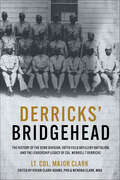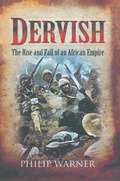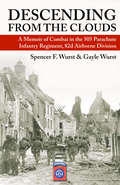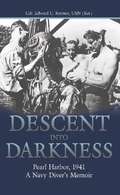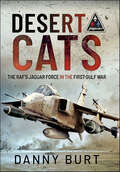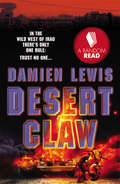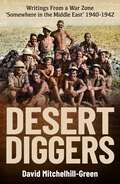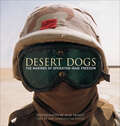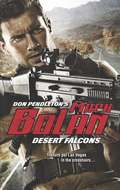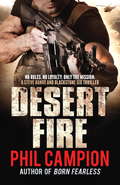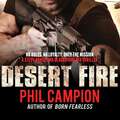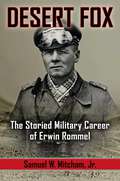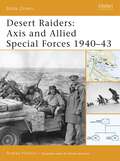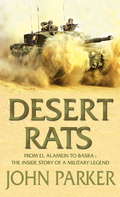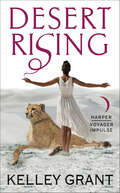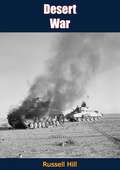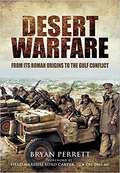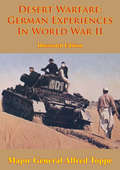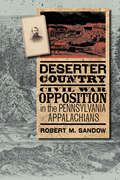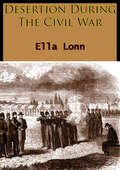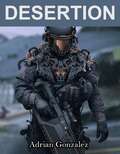- Table View
- List View
Derricks' Bridgehead: The History of the 92nd Division, 597th Field Artillery Battalion, and the Leadership Legacy of Col. Wendell T. Derricks
by Lt. Col. ClarkFinalist, 2023 Army Historical Foundation Distinguished Writing Awards"[The author] saw firsthand the unit's hardships and setbacks, but also its successes and victories. His brings this direct knowledge to bear in this detailed and fascinating look at the experiences of African American military units during the war."— WWII History Magazine The 597th Field Artillery Battalion, 92nd Division, was the first, last, and only all-black officered direct support field artillery battalion committed to combat in the history of the U.S. Army. It was the first all-black unit in a combat division and, together with the 600th Field Artillery Battalion, constituted the only all-black units in any combat division. Alongside impressive achievements on the battlefield in Italy in 1944–45, the unit provided more key command and staff positions exclusively for black field artillery officers than any other U.S. Army unit in combat, giving combat training and experience to more senior black field artillery officers than any of the other 16 black field artillery battalions during World War II. Colonel Wendell Derricks worked to shelter his troops from the worst of the racism exhibited during the war and, due to his ability to envision an integrated postwar army, he provided unique leadership opportunities for his senior officers. The alumni of the 597th Field Artillery Battalion have an impressive record of success, many of them were inducted into the Field Artillery Hall of Fame; some served at the Pentagon, including Lieutenant Colonel Clark; and others forged successful careers in the civilian world.
Dervish: The Rise and Fall of an African Empire (Wordsworth Military Library)
by Philip WarnerDervish is the vivid and colourful story of one of the more remarkable episodes in the high Empire period of British history. The Mahdis rising in the Sudan in the 1880s starting as a localized Holy War against the decadent Turkish/Egyptian overlords, engulfed a million square miles of arid territory and forced the British Liberal Government to get involved after the early disasters of the Hicks expedition and Gordons death at Khartoum.The narrative, which makes excellent use of the first-hand diaries and reports, including those of Rider Haggards brother Andrew and of Father Ohrwalder (the Austrian missionary who spent ten years of captivity in the Mahdis camp), brilliantly describes the growth and strength of the Mahdist movement and the extraordinary devotion and discipline of the Dervish troops. Facing such opponents with stoic endurance were the British, Egyptian and Sudanese Negro soldiers, and the resulting military engagements evoked amazing feats of courage and derring-do on both sides.The Dervish Empire outlasted the Mahdi by thirteen years. It ended in the battle of Omdurman and Kitcheners reconquest of the Sudan, which was well supported by Reginald Wingates military intelligence operations. It lasted a comparatively brief span of time, but it had been established at the expense not only of the neighbouring Abyssinians but also of the European white man, at a time when Britain was approaching the zenith of its imperial power.Philip Warner is author of Passchendale and The Zeebrugge Raid and numerous other first rate histories. He wrote the biographies of Auchinleck and Horrocks. He was the military obituary writer of The Daily Telegraph for many years. In WW2 he was a POW of the Japanese for 1,000 days. He died in 2000.
Descending from the Clouds
by Gayle Wurst Spencer F. WurstWearing the remnants of a WWI uniform and pulling a water-cooled 30-caliber machine-gun, Spencer Wurst marched through his hometown of Erie, Pennsylvania, in 1940 as a member of the National Guard. He was 15 years old. Five years later he was a hardened platoon sergeant leading his troopers through the frozen killing fields of "Death Valley" in Germany's Heurtgen Forest. A squad leader in Company F, 505 Parachute Infantry Regiment, 82d Airborne, for most of the war, Wurst jumped into Italy in September 1943, and received his baptism of fire at Arnone. Jumping into Normandy on D-Day, he received his first Purple Heart in the liberation of Ste. Mère-Eglise, and a second Purple Heart in grueling combat through the hedgerows. On his third jump, Wurst's bravery under fire earned him the coveted Silver Star when he and his fellow paratroopers were swept up in the ferocious battle with the SS for the Highway Bridge at Nijmegen, Holland, in Operation Market Garden. A few months later, the dawn of his twentieth birthday found him serving on point in the long, freezing march to the shoulder of the Bulge. A unique view of combat from pre-war training and mobilization to First Army maneuvers, parachute school at Fort Benning, and Europe's killing fields, Wurst's poignantly written and carefully researched memoir has been hailed as an outstanding addition to the literature of WWII.
Descent into Darkness
by USN Edward C. RaymerOn December 7, 1941, as the great battleships Arizona, Oklahoma, and Utah lie paralyzed and burning in the aftermath of the Japanese attack on Pearl Harbor, a crack team of U.S. Navy salvage divers headed by Edward C. Raymer are hurriedly flown to Oahu from the mainland. The divers have been given a Herculean task: rescue the sailors and Marines trapped below, and resurrect the pride of the Pacific fleet.Now for the first time, the chief diver of the Pearl Harbor salvage operations, Cmdr. Edward C. Raymer, USN (Ret.), tells the whole story of the desperate attempts to save crewmembers caught inside their sinking ships. Descent into Darkness is the only book available that describes the raising and salvage operations of sunken battleships following the December 7th attack.Once Raymer and his crew of divers entered the interiors of the sunken shipwrecks-attempting untested and potentially deadly diving techniques-they experienced a world of total blackness, unable to see even the faceplates of their helmets. By memorizing the ships' blueprints and using their sense of touch, the divers groped their way hundreds of feet inside the sunken vessels to make repairs and salvage vital war material. The divers learned how to cope with such unseen dangers as falling objects, sharks, the eerie presence of floating human bodies, and the constant threat of Japanese attacks from above.Though many of these divers were killed or seriously injured during the wartime salvage operations, on the whole they had great success performing what seemed to be impossible jobs. Among their credits, Raymer's crew raised the sunken battleships USS West Virginia, USS Nevada, USS California, After Pearl Harbor they moved on to other crucial salvage work off Guadalcanal and the sites of other great sea battles.
Descent: Descent (Star Trek: The Next Generation)
by Diane CareyThe Borg are back -- and nastier than ever. No longer mindless, inhuman drones but cyborg soldiers on a mission to assimilate all intelligent life, their new goal is the complete destruction of the Federation. And in the midst of facing the Borg again, Captain Picard learns that he may be the cause of the change. Commander Data is changing as well. For the first time in his life, Data feels a genuine emotion -- and that emotion is deadly, destructive rage. When it is revealed that the Borg are commanded by an old enemy out of Data's past, Data must choose between his allegiance tot he Federation and the one thing he wants above all else...
Description and Analysis of the VA National Formulary
by Institute of MedicineThe National Academies Press (NAP)--publisher for the National Academies--publishes more than 200 books a year offering the most authoritative views, definitive information, and groundbreaking recommendations on a wide range of topics in science, engineering, and health. Our books are unique in that they are authored by the nation's leading experts in every scientific field.
Desert Cats: The RAF's Jaguar Force in the First Gulf War
by Danny BurtOn 2 August 1990, Saddam Hussein’s armed forces invaded and occupied Kuwait. A swift international response followed, which, led by the United States and the United Kingdom, saw the formation of a coalition that formed the largest military alliance seen since the end of the Second World War. Among the many RAF units deployed under Operation Granby, the codename given to the British military operations during the conflict, was 41 Squadron, with elements taken from 54 Squadron and 226 OCU, which was equipped with the ubiquitous Jaguar GR1 single-seat all-weather tactical strike and ground-attack fighter. In late 1990, the squadron duly despatched a total of twelve aircraft, which soon became known for their distinctive desert pink camouflage, and twenty-two pilots from their base at RAF Coltishall. Initially conducting low-level strikes, for which the Jaguar Force had always been intended, over the weeks that followed 41 Squadron switched to more unusual medium-level missions. In total, the men and machines of 41 Squadron conducted a total of 617 sorties during Operation Granby. To complete this remarkable description of 41 Squadron’s part in the liberation of Kuwait, the author has interviewed a number of these pilots. As well as these veterans’ personal reflections, Danny Burt also explores the Jaguars’ record on air-to-ground combat and its performance in theatre, the various upgrades the type receive, and the unique nose art that each aircraft carried. Many of the pictures in this highly illustrated publication have never been published before. The story is completed by the recovery by the author of one of the Jaguar GR1s flown in the Gulf WarRescued from an Army range in South Wales, the aircraft was moved to RAF Coningsby where its restoration, including the return of its Operation Granby camouflage, is underway.
Desert Claw
by Damien LewisIraq: the present day. A country torn apart by war and anarchy. Thieves roam the streets. People are being killed in broad daylight. Security is non-existent. And now, terrorists have seized a Van Gogh painting worth £25 million from one of Saddam's palaces. They are offering it to the highest bidder. The painting's original owner, a Kuwaiti prince, from whom it was seized during Iraq's occupation of Kuwait in the First Gulf War, has asked for HMG's help in retrieving it. The British Government owes him a favour for backing them during the Iraq War, so they agree to help. But rather than agreeing to pay the terrorists' ransom -- which they fear will be pumped into funding terrorist operations across the world -- HMG decides to send in a team of hardened ex-Special Forces, led by ex-SAS hero Mick Kilbride and his sidekick 'East End' Eddie. Sent undercover in a deniable operation called Desert Claw, their brief is simple: retrieve the painting, and eliminate the terrorists at the earliest possible opportunity. The mission sounds simple enough. But as Mick and his team are drawn into a dark and violent world, things are not always as they seem. And in the final climactic scene, a horrible and shocking truth awaits for the men.
Desert Diggers: Writings From a War Zone 'Somewhere in the Middle East' 1940-1942
by David Mitchelhill-GreenDesert Diggers: Writings from a War Zone &‘Somewhere in the Middle East&’ 1940-1942 draws upon hundreds of soldiers&’ letters in a fresh and captivating narrative of the war in North Africa. Desert Diggers follows the first men to volunteer after the outbreak of war in 1939, tracing their adventures in exotic ports before further training in Palestine. A hunger for action grew: &‘Most of the chaps are ... anxious to get into anything that looks like a fight&’, one soldier wrote to his brother. From Egypt, &‘the hottest and dustiest place on God's earth&’ was the Diggers&’ next destination and their &‘blooding&’ in the battles for Bardia and Tobruk. After Rommel failed to storm Tobruk in April-May 1941, Nazi propaganda denigrated the garrison, &‘caught like rats in a trap&’. Amid frequent bombing and shelling, Berlin&’s scornful broadcasts were an unintended tonic. &‘Frequently we laughed and joked until the tears came into our eyes&’, a Digger quipped. From Tobruk, to the blunting of Rommel&’s attacks at El Alamein, the price of victory was palpably high: &‘some of my best mates didn't come out of it&’, lamented a corporal to his sister. Returning to Australia in 1943, some men maimed or traumatised, brought a further test for the Diggers ...Told in the words of the men who served, Desert Diggers offers a new personal perspective on the Western Desert campaign. With immediacy and raw emotion, these skillfully woven letters provide a remarkable and compelling account of the Australian experience of war.
Desert Dogs: The Marines of Operation Iraqi Freedom
by Amy Goodpaster Strebe Russ BryantA photographic account that highlights the human side of war, the day-in-the-life of US Marines stationed in Iraq.Desert Dogs includes dramatic, harrowing, and simply unbelievable images of the marines of Operation Iraqi Freedom, personal letters, and stories of coping with the pain of separation from their families and the horrors of war. Russ Bryant’s photography chronicles every aspect of the daily lives of these marines: lazy camels amble by a cargo drop; blinding sandstorms threaten to blow away tents, supplies, and marines alike; Scud missile attack sirens send marines scuttling to their bunkers; sniper fire crisscrosses marine convoys moving into Iraq; tanks and bombs topple the portraits of Saddam that seem to loom over every Iraqi village; shelled-out tanks, armored vehicles, and even busses litter the road on the way to Baghdad; medical personnel attend to fallen marines and prisoners alike; the occasional silent interlude allows time for prayer and remembrance.
Desert Exile: The Uprooting of a Japanese-American Family
by Yoshiko UchidaDesert Exile chronicles the experiences of a well-to-do Japanese American family before and during the internment of Japanese-Americans during the Second World War.
Desert Falcons
by Don PendletonROYAL CONSPIRACY In the Kingdom of Saudi Arabia, a secret group within the military is plotting to oust the Royal Family. Their next move: kidnapping the playboy prince from a desert warfare training session outside Las Vegas. But Sin City already has its share of trouble, with authorities investigating the disappearance of two park rangers and coping with threats made by an anti-Muslim rancher who has a highly efficient militia of his own. It falls to Mack Bolan to keep the prince safe at all costs. But someone in the heir's inner circle is a traitor, and the agents working the park ranger case are bound by official procedure. When it comes to stopping the fall of a kingdom and preventing a bloodbath on US soil, the Executioner makes his own rules.
Desert Fire
by Phil CampionSultan Gadaffi has escaped from Libya with a fistful of dangerous secrets. The British Government want ex-Special Forces operative Steve Range, the go-to man for any Black-Ops missions, to lead an ultra-covert mercenary group to seize him from his near-impregnable desert stronghold. Saed is defended by Tuareg warriors armed to the teeth with stolen NATO hardware. If Range's team can somehow overcome them, then they will earn themselves gold bullion worth $500 million. But as the bullets begin to fly and the body count rises, Range realises that he's been double-crossed. Unwilling to lose the gold, he begins to contemplate cutting a deal with the devil.
Desert Fire
by Phil CampionSultan Gadaffi has escaped from Libya with a fistful of dangerous secrets. The British Government want ex-Special Forces operative Steve Range, the go-to man for any Black-Ops missions, to lead an ultra-covert mercenary group to seize him from his near-impregnable desert stronghold. Saed is defended by Tuareg warriors armed to the teeth with stolen NATO hardware. If Range's team can somehow overcome them, then they will earn themselves gold bullion worth $500 million. But as the bullets begin to fly and the body count rises, Range realises that he's been double-crossed. Unwilling to lose the gold, he begins to contemplate cutting a deal with the devil.(P)2013 WF Howes Ltd
Desert Fox: The Storied Military Career of Erwin Rommel (Stackpole Military History Ser.)
by Samuel W. MitchamJust who was Erwin Rommel? War hero or war criminal? Hitler flunky or man of integrity? Military genius or just lucky? Now, bestselling military historian Samuel W. Mitcham Jr. gets to the heart of the mysterious figure respected and even admired by the people of the Allied nations he fought against. Mitcham recounts Rommel’s improbable and meteoric military career, his epic battles in North Africa, and his fraught relationship with Hitler and the Nazi Party. Desert Fox: The Storied Military Career of Erwin Rommel reveals: • How Rommel’s victories in North Africa were sabotaged by Hitler’s incompetent interference • How Rommel burned orders telling him to commit war crimes • Why it wouldn’t have helped Patton if he really had read Rommel’s book • How Rommel was responsible for the Germans’ defense against the D-Day landing • Why the plot to overthrow Hitler was fatally compromised when Rommel was gravely injured in an Allied attack • The reason Rommel agreed to commit suicide after his part in the plot was discovered by Hitler Mitcham’s gripping account of Rommel’s life takes you through the amazing adventure of the World War II battles in North Africa. Again and again, Rommel outfoxed the Allies—until the war of attrition and Hitler’s blunders doomed the Axis cause. Illustrated with dozens of historical photos, this illuminating biography paints a fascinating and tragic picture of the man known as the Desert Fox.
Desert Raiders: Axis and Allied Special Forces 1940-43
by Andrea MolinariAlthough harsh and inhospitable, the North African theatre of World War II proved to be a perfect environment for irregular warfare and the deployment of Special Forces. Following Italy's entry into the war in June 1940, the Western Desert became the background for a long conflict dominated by motorized units. The major combatants - Great Britain, Free France, Italy and Germany - all developed irregular units to exploit the unique conditions of the region with varying degrees of success. This book details the genesis, organization and tactics of these forces, including such famous units as the Long Range Desert Group and the Special Air Service.
Desert Rats
by John ParkerIn the recent war in Iraq, the 7th Armoured Brigade, bearers of the Desert Rats insignia, was immediately engaged in some of the fiercest early fighting, ultimately taking Basra for the Allies. The war in Iraq revived public focus on the Desert Rats whose famous battles of World War II helped turn the tide of German dominance. After World War II the Desert Rats re-emerged as part of the NATO forces during the Cold War years, and in other major deployments in the 1991 Gulf War, Bosnia and Kosovo. In this latest of his military histories, John Parker once again draws heavily on the drama of first-hand accounts for a story that is a seminal part of modern military history.
Desert Rats
by John ParkerIn the recent war in Iraq, the 7th Armoured Brigade, bearers of the Desert Rats insignia, was immediately engaged in some of the fiercest early fighting, ultimately taking Basra for the Allies. The war in Iraq revived public focus on the Desert Rats whose famous battles of World War II helped turn the tide of German dominance. After World War II the Desert Rats re-emerged as part of the NATO forces during the Cold War years, and in other major deployments in the 1991 Gulf War, Bosnia and Kosovo. In this latest of his military histories, John Parker once again draws heavily on the drama of first-hand accounts for a story that is a seminal part of modern military history.
Desert Rising (Desert Rising Novels #1)
by Kelley GrantIn this astonishing debut, Kelley Grant begins the Desert Rising trilogy by bringing to life a powerful new epic fantasy tale of determination and self-discovery.The Temple at Illian is the crown jewel of life in the Northern Territory. There, pledges are paired with feli, the giant sacred cats of the One god, and are instructed to serve the One’s four capricious deities. Yet Sulis, a young woman from the Southern Desert, has a different perspective - one that just might be considered heresy, but that is catching on rather quickly… Sulis’s twin Kadar, meanwhile, is part of a different sort of revolution. When Kadar falls in love with a woman from a Forsaken caste, he finds he’s willing to risk anything to get these people to freedom. But with Sulis drawing a dangerous level of attention from the deities, and war about to break out on two fronts, change may not come as easily as either twin had hoped.
Desert War
by Russell HillThis is the kind of book you’ve been waiting for about the war—a book by a correspondent who was in the thick of the actual fighting, in the front lines and sometimes ahead of them. Only in North Africa, because of the strange fluid quality of desert tactics, have correspondents actually been allowed to see men in battle—to attach themselves to fighting units and to move constantly with those units. It is this which gives its unique quality to Russell Hill’s account of the second British invasion of Cyrenaica.Mr. Hill is the brilliant young Cairo correspondent of the New York Herald Tribune. He knew the campaign was going to start days before it actually did; and he was permitted to inspect oasis outposts, supply dumps, and even Tobruk itself, still surrounded and still magnificently holding out. When the big “flap” began, Hill moved out with a forward unit, and was immediately plunged into that made swirling melee that is deeper fighting, and to which no description short of Hill’s own can do justice.If you were puzzled by the reports which came for days from Sidi Rezegh, where Rommel made his stand and his escape; if your heart leapt at the relief of Tobruk; if your hopes were raised then the British reached El Agheila, and were dashed down again when Rommel lashed back to Tobruk and the Egyptian border—you will find all the answers and the explanations in this book.With 14 illustrations and 5 maps.
Desert Warfare: From Its Roman Origins to the Gulf Conflict
by Bryan PerrettApproximately one-fifth of the earth's surface consists of desert, and throughout history these arid regions have witnessed some of the world's most decisive battles. Here, Bryan Perrett gives an absorbing account of desert conflicts from the first century BC to more contemporary conflicts such as those in Iran and Iraq. As he demonstrates, acclimatization and familiarization with the day-to-day problems of desert life are vital not only to teach troops how to protect themselves and their equipment, but also to bring them to terms with the harsh environment. The desert does not compromise, and battles fought there result in total victory or total defeat, often at horrific cost. Initially released in 1988 by Patrick Stephens Limited, this re-issue marks a determination on the author's and the publisher's part to keep an esteemed publication in print.
Desert Warfare: German Experiences In World War II [Illustrated Edition]
by Major General Alfred ToppeIncludes 112 photos/illustrations and 21 maps.The German Afrika Korps blazed a trail across the deserts of North Africa under their dashing leader Erwin Rommel, the Desert Fox, although finally defeated by far superior Allied Forces they set the gold standard for desert operations. This book is of great historical value and even in the present day it is still considered of great value by the American military who still seek for improvements in their ways of desert doctrine..."Analysts continue to assess the data from Operations Desert Shield and Desert Storm as a means of improving the military's ability to function efficiently in desert terrain...The information gleaned from this effort will enhance the already considerable body of knowledge on the subject derived from the historical record...When contributions in the latter category are located or rediscovered, they should be given the dissemination they merit..."Such is the purpose of publishing Desert Warfare: German Experiences in World War II...Organized by Major General Alfred Toppe and written with the assistance of nine German commanders who served in North Africa, the manuscript...represents a collaborative attempt to determine "as many factors as possible which exerted a determining influence on desert warfare," Issues addressed include planning, intelligence, logistics, and operations. Described and analyzed are the German order of battle, the major military engagements in North Africa, and the particular problems of terrain and climate in desert operations. Not unlike many of the U.S. units engaged in the war with Iraq, the Germans in North Africa learned about combat operations in the desert only after they arrived on the scene and confronted the desert on its own terms. For this reason alone, as well as for the insights it offers, Desert Warfare requires the serious consideration of those responsible for preparing the U.S. military for any future conflict in desert terrain."
Deserter Country: Civil War Opposition in the Pennsylvania Appalachians (The North's Civil War)
by Robert M. SandowDuring the Civil War, there were throughout the Union explosions of resistance to the war -from the deadly Draft Riots in New York City to other, less well-known outbreaks. In Deserter Country, Robert Sandow explores one of these least known "inner civil wars", the widespread, sometimes violent opposition in the Appalachian lumber country of Pennsylvania.Sparsely settled, these mountains were home to divided communities that provided safe-haven for opponents of the war. The dissent of mountain folk reflected their own marginality in the face of rapidly increasing exploitation of timber resources by big firms, as well as partisan debates over loyalty. One of the few studies of the northern Appalachians, this book draws revealing parallels to the War in the southern mountains, exploring the roots of rural protest in frontier development, the market economy, military policy, partisan debate, and everyday resistance. Sandow also sheds new light on the party politics of rural resistance, rejecting easy depictions of war-opponents as traitors and malcontents for a more nuanced and complicated study of the class, economic upheaval, and localism.
Desertion During The Civil War (History Of The United States Ser.)
by Ella LonnDesertion during the Civil War, originally published in 1928, remains the only book-length treatment of its subject. Ella Lonn examines the causes and consequences of desertion from both the Northern and Southern armies. Drawing on official war records, she notes that one in seven enlisted Union soldiers and one in nine Confederate soldiers deserted.Lonn discusses many reasons for desertion common to both armies, among them lack of such necessities as food, clothing, and equipment; weariness and discouragement; non-commitment and resentment of coercion; and worry about loved ones at home. Some Confederate deserters turned outlaw, joining ruffian bands in the South. Peculiar to the North was the evil of bounty-jumping. Captured deserters generally were not shot or hanged because manpower was so precious. Moving beyond means of dealing with absconders, Lonn considers the effects of their action. Absenteeism from the ranks cost the North victories and prolonged the war even as the South was increasingly hurt by defections. This book makes vivid a human phenomenon produced by a tragic time.-Print ed."[The book is] better calculated to convey a sense of the sickening realities of the Civil War than many volumes of military history."--American Historical Review"An excellent piece of historical research."--Journal of Negro History
Desertion: Humanitarian Redemption
by Adrián GonzalezA rookie is promoted after performing a great feat by eliminating an alien nest. Ovated by all his teammates after receiving the medal of honor, he is transferred to the special team. His mission, the destiny of humanity. In a last attack forced by the allies to finally finish with the Tungs. But what would become of us if everything they tell us is a lie. To discover the truth in a war. To have in the hands the absolute truth written by an enemy. Could you decide who is the good and who is the evil? We all make decisions, the young legend should make only one, as a result of the extinction of the human race.
